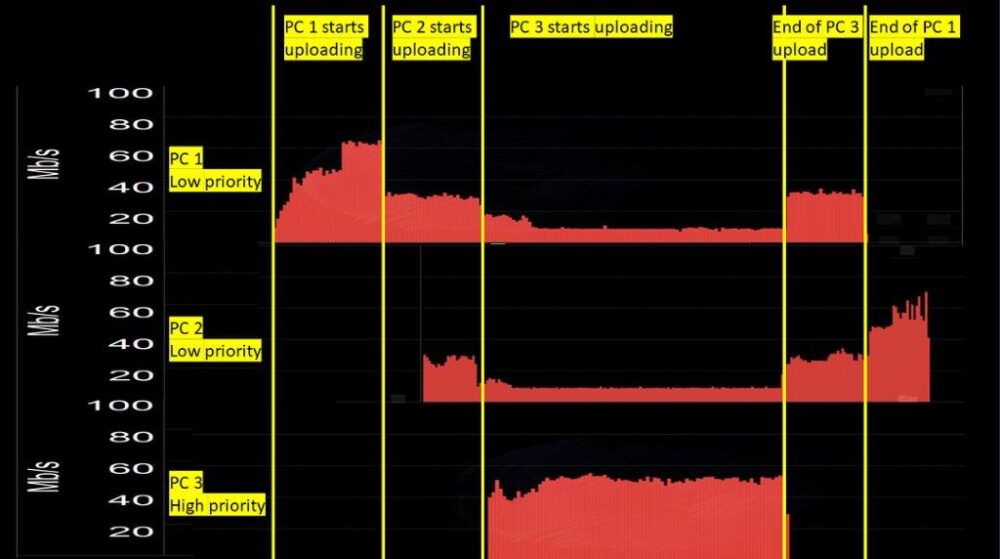Published : 16/09/2024

5mn reading time
Cloud Gaming has tested 5G

Business sector
Gaming / Entertainement

Gamers needs
- Cross-platform compatibility
- Reduced latency and high performance for a seamless gaming experience without compromising graphic quality
- A wide-ranging catalog from simple games to the latest sophisticated ones

Solution
- 5G for streaming high-quality games and playing in immersive environments
- Slicing to play without the risk of lag or freeze during traffic spikes

5G key advantages
Network slicing: the key asset of 5G SA
Network slicing is probably the most eagerly awaited feature of 5G SA. It will enable a large number of critical uses to be secured.
One of the problems with mobile networks is that users have different, more or less critical needs
explains Julien Péraudeau, Product Manager at Orange 5G Lab Châtillon. For example, in the security sector, some players need to have 100% network availability and receive priority when managing an event. In the healthcare sector, it goes without saying that certain uses, such as telesurgery, cannot be carried out without the guarantee of sufficient network resources. Finally, the media may need to secure live broadcasts on an as-needed basis. For this reason, Orange 5G Lab teams have tested this functionality in several stages since 2022, together with their partner Huawei.
The concept behind slicing: dynamic bandwidth allocation based on needs
The concept is simple: when a user benefits from slicing, they get network resources tailored to their specific performance and security needs.
Demoed with 3 users, 2 of them with a baseline (“default”) priority, the 3rd one granted a high priority, who perform a basic file transfer:
- The first default user downloads a file, they benefit from all available bandwidth.
- A second default user then starts a download, the bandwidth is shared between these two users.
- The third and priority user then connects to the service and is granted the priority slice. In our demo configuration, the network dynamically gives that user half the bandwidth, while the first two users share the remaining half. As soon as the priority user has finished their download, the total bandwidth is dynamically reallocated by the network to the other users.
On the radio side, slice configuration makes it possible to define the maximum bandwidth allocated to the slice on the one hand, and the minimum bandwidth on the other. Operators thus have the tools they need to adapt the network and quality of service to users’ specific needs. All that remained to be done was to test the functionality on a real-life application that faces significant constraints: cloud gaming.

Cloud Gaming: the challenge of user experience
Imagine: you order your hero to perform an action, but there is a very slight delay in the connection. The hero responds a second too late and dies: every gamer’s worst nightmare.
Poor network can induce inconveniences such as high latency, pixelated scenery or inconsistent framerate. Whilst those immersion-breaking inconveniences are mitigated on a videogame console, they can absolutely ruin a cloud gaming experience, crushing image quality or responsiveness. Instead of running games locally, cloud gaming utilizes the internet, running on powerful remote servers to stream video and audio on the player’s chosen device (including smartphones, tablets, and low-powered laptops). As a result, the interactive nature of cloud gaming really shines when it relies on a highly optimized, high quality-of-service network that ensures both high and consistent performance – thus making 5G slicing particularly relevant.
Since 2023, Orange and Huawei have been testing end-to-end slice configuration, meaning from the user to the server hosting the service, within a cloud gaming environment at Orange Gardens. The staff in charge of the experiment have shed some light on the background behind this multi-stage experiment.
How does slicing boost cloud gaming?
At the end of 2023, as part of the slicing tests conducted for streaming games, the teams created two slices. This 1st experiment demonstrated how networks dynamically manage resources.
“We split the network in two, so to speak”, explains Julien Péraudeau. This means creating a standard slice, or the common network shared by all users, and a priority slice. “We then went on to develop more advanced functions, such as priority level management across the various nodes of the network, through the different routers to reach the services. These tools at our disposal enable us to manage traffic priority: with specific settings, we can specify which user has priority for each node.”
Explained in greater detail by Patrick Lohat, Huawei marketing manager (in charge of the Orange partnership), “network slicing can be implemented by different mechanisms at the level of each of the network’s components:”
- the radio part, where resource block reservation is installed,
- the transmission network, where we use FlexE and channelized sub-interface,
- then the core network with its dedicated resources.”
Once these new functions have been programmed, the result is the bandwidth required for a latency-free cloud gaming experience and interactions with other players. The gaming session is protected even if the network faces a temporary overload.
For Patrick Lohat, this network combined with the slicing function becomes “a facilitator that will enable the operator to guarantee the quality of the user experience”.
Next step: exhibiting the network’s capacities via APIs
The latest test, carried out in July 2024, involved implementing on-demand slice configuration for the cloud gaming service.
With this new development, Huawei is demonstrating the ability for users to configure the desired quality of service on demand and in real time.
Based on this functionality, operators will be able to offer standardized, easy-to-use APIs for services that leverage the potential of 5G networks.
For example, the quality on demand API, offered by Orange as part of its set of standardized CAMARA APIs, makes it possible to offer mobile users an enhanced connection (bandwidth, latency) to achieve a first-rate experience for gaming, holography or virtual reality sessions. And all without the need for in-depth knowledge of 4G/5G networks or the overall complexity of telecoms systems.
Based on this test, we can soon imagine slicing being used in many other fields. For example, prioritizing customers (public services, hospitals, emergency services, etc.) on a bandwidth in the event of network saturation. Or applying dynamic prioritization at the terminal, with network separation directly between applications (some would use the priority bandwidth, others would run on the standard network…).
As Julien Péraudeau emphasizes: “This would also make it possible to understand that 5G is not necessarily reserved only for high data consumption, but it can also meet critical and intense needs for small amounts of traffic. In other words, we can do away with the need for more and more bandwidth thanks to the latest technology.”

*FOCUS on :
“Slicing”
Network slicing consists in virtually slicing up a network to better meet different user needs.
“Jitter”
Jitter is a variation in latency over time, measured in ms, caused by network congestion, routing changes, packet loss, buffering and interference. It affects the seamlessness of real-time services such as voice and video.

Subscribe to our Orange 5G Lab newsletter
